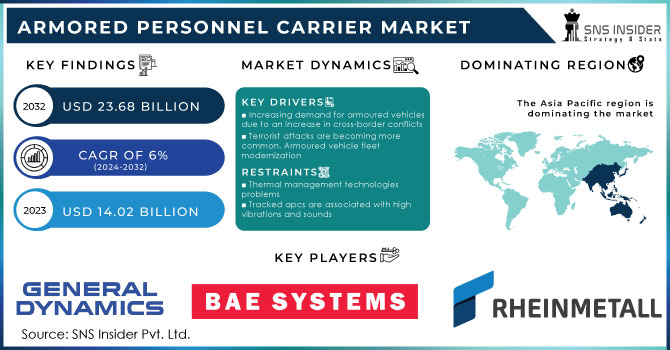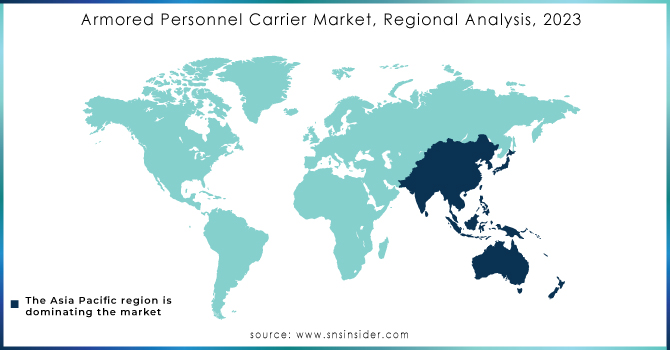Armored Personnel Carrier Market Report Scope & Overview:

To get more information on Armorred Personnel Carrier Market - Request Free Sample Report
The Armored Personnel Carrier Market Size was valued at USD 14.02 billion in 2023 and is expected to reach USD 23.68 billion by 2032 with a growing CAGR of 6% over the forecast period 2024-2032.
The APCs weigh less than the newborn war chariots and the main battle tanks so they go much further. Unlike infants (IFVs), APCs do not participate in direct fire fighting and are designed to transport. However, they are well equipped to defend themselves and armed to protect themselves from reduced weapons, small arms, and shotguns. In addition, certain types of APCs are used by non-military organizations.
The growth of the global arms market is due to the increasing cost of war and the increase in terrorist incidents worldwide. In addition, the modern manufacture of armored vehicles also drives the growth of the market carrying armed workers. However, issues related to heat management technology and high vibration and noise associated with the APC process are expected to disrupt the market in a negative way. In contrast, technological advances and the introduction of new armored vehicles are expected to provide significant growth opportunities in the labor market carrying armed workers.
MARKET DYNAMICS
KEY DRIVERS
-
Increasing demand for armoured vehicles due to an increase in cross-border conflicts
-
Terrorist attacks are becoming more common. Armoured vehicle fleet modernization
RESTRAINTS
-
Thermal management technologies problems
-
Tracked apcs are associated with high vibrations and sounds
CHALLENGES
-
Main combat tanks are expensive
-
Issues of Survivability
OPPORTUNITIES
-
Armoured vehicle development that is modular and scalable
-
Increased use of unmanned combat ground vehicles by many countries' military forces
THE IMPACT OF COVID-19
The COVID-19 pandemic has had a multifaceted influence on world economies. Global automotive part, component, and assembly line manufacturing has been badly hit. Although the construction of armoured vehicles is critical, supply chain issues have slowed production for the time being.
The level of COVID-19 exposure a country faces, the level at which manufacturing operations are running, and import-export rules, among other factors, all influence the resumption of armoured vehicle manufacturing and deliveries. Although businesses may still accept orders, delivery timetables may not be fixed.
The worldwide armoured personnel carrier market has been divided into two types based on design: wheeled APC and tracked APC. The wheeled APC category dominated in terms of value and is predicted to grow at a rapid pace throughout the forecast period. Because of the lower friction losses, wheeled APCs often offer superior fuel efficiency than tracked APCs. As a result, wheeled APC have wider operational ranges. Furthermore, wheeled APCs are less expensive and require less maintenance and spare parts than tracked APCs, making wheeled APCs more reliable than tracked APCs.
The global armoured personnel carrier market is divided into two types: amphibious and non-amphibious. Amphibious APCs are frequently outfitted with propellers or water jets, or they are propelled by their tracks. The speed of water traversal varies widely between vehicles and is much slower than terrestrial speed. The armoured vehicles market has been divided into combat vehicles, combat support vehicles, and unmanned armoured ground vehicles based on platform. During the forecast period, the combat vehicle sector is expected to lead the armoured vehicles market. Global demand for Armored Personnel Carriers and Light Armored Vehicles is driving expansion in the combat vehicle section of the market.
KEY MARKET SEGMENTATION
By Design
-
Wheeled APC
-
Tracked APC
By Range
-
Less than 500 km
-
More than 500 km
By Carrying Capacity
-
Less than 10,000 Kg
-
Greater than & Equal to 10,000 Kg
By Configuration
-
Amphibious
-
Non-Amphibious
By Number of Occupants
-
Less than 10
-
10-15
-
More than 15
By End User
-
Military
-
Law Enforcement
-
Others
REGIONAL ANALYSIS
The Asia Pacific armored market market is expected to grow at a very high CAGR from till 2028. . Countries like India and China have increased their defense budget and purchased advanced armored vehicles to carry out their military duties. This, in turn, is expected to further the growth of the Asia Pacific armored market during the forecast period.
The latest pandemic of COVID-19 is expected to have an impact on the global automotive industry, including the armaments industry. The entire supply chain is disrupted due to limited availability of components. Chinese suppliers around the world have suspended production lines or closed them altogether. Also, legal and commercial restrictions, such as closed borders, increase the shortage of required components. Such disruptions in the supply chain are expected to affect the integration of OEMs in Europe and North America.

Need any customization research on Armorred Personnel Carrier Market - Enquiry Now
REGIONAL COVERAGE:
-
North America
-
USA
-
Canada
-
Mexico
-
-
Europe
-
Germany
-
UK
-
France
-
Italy
-
Spain
-
The Netherlands
-
Rest of Europe
-
-
Asia-Pacific
-
Japan
-
south Korea
-
China
-
India
-
Australia
-
Rest of Asia-Pacific
-
-
The Middle East & Africa
-
Israel
-
UAE
-
South Africa
-
Rest of Middle East & Africa
-
-
Latin America
-
Brazil
-
Argentina
-
Rest of Latin America
-
KEY PLAYERS
The Major Players are General Dynamics Corporation, BAE Systems plc, NORINCO, Rheinmetall AG, Textron Inc, Oshkosh Corporation, UralVagonZavod, Ukroboronprom, Katmerciler A.S., KMDB A.A., and other players.
| Report Attributes | Details |
|---|---|
| Market Size in 2023 | US$ 14.02 Billion |
| Market Size by 2032 | US$ 23.68 Billion |
| CAGR | CAGR of 6% From 2023 to 2032 |
| Base Year | 2023 |
| Forecast Period | 2024-2032 |
| Historical Data | 2020-2022 |
| Report Scope & Coverage | Market Size, Segments Analysis, Competitive Landscape, Regional Analysis, DROC & SWOT Analysis, Forecast Outlook |
| Key Segments | • By Design (Wheeled APC and Tracked APC) • By Range (Less than 500 km and More than 500 km) • By Carrying Capacity (Less than 10,000 Kg and Greater than & Equal to 10,000 Kg) • By Configuration (Amphibious and Non-Amphibious) • By Number of Occupants (Less than 10, 10-15, and More than 15) • By End User (Military, Law Enforcement, and Others) |
| Regional Analysis/Coverage | North America (USA, Canada, Mexico), Europe (Germany, UK, France, Italy, Spain, Netherlands, Rest of Europe), Asia-Pacific (Japan, South Korea, China, India, Australia, Rest of Asia-Pacific), The Middle East & Africa (Israel, UAE, South Africa, Rest of Middle East & Africa), Latin America (Brazil, Argentina, Rest of Latin America) |
| Company Profiles | General Dynamics Corporation, BAE Systems plc, NORINCO, Rheinmetall AG, and Textron Inc, Oshkosh Corporation, UralVagonZavod, Ukroboronprom, Katmerciler A.S., KMDB A.A., and other players. |
| DRIVERS | • Increasing demand for armoured vehicles due to an increase in cross-border conflicts • Terrorist attacks are becoming more common. Armoured vehicle fleet modernization |
| RESTRAINTS | • Thermal management technologies problems • Tracked apcs are associated with high vibrations and sounds |

